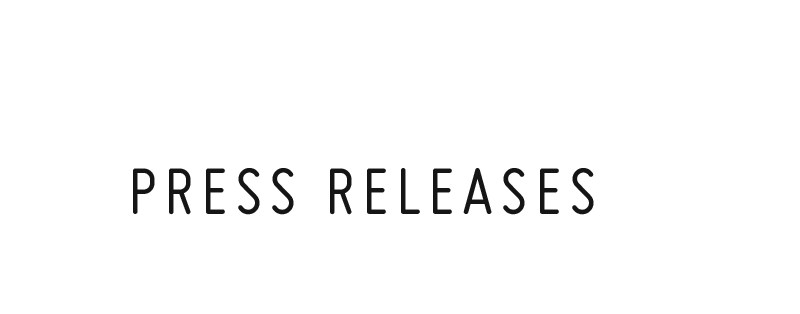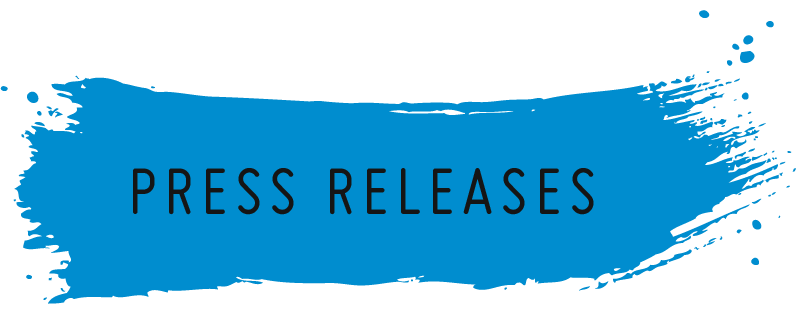- 3D Print Bureau
- 6K
- Agmatix
- Airwayz
- AM-Flow
- Appadda
- Caracol
- CG Trader
- CyberOptics
- e-Xstream
- GenCell
- GreenEye
- Impossible Objects
- Incus Media
- InkBit
- ITG
- JPB Systeme
- KeyProd
- Landa
- LEO Lane
- Lumet
- Magic Software
- MakerBot
- Marketiger
- Nano Dimension
- Paragon Rapid Technologies
- PearlX
- Plant & Bean
- Redefine Meat
- Replique
- Ripples
- Sakuu Corporation
- SolarEdge
- StoreDot
- Stratasys
- Sunrock
- The Bespoke Group
- Trigo
- UltiMaker
- Xjet
ITALIAN SCIENTIFIC RESEARCH CENTER INFN USES STRATASYS 3D PRINTING TO PRODUCE PARTS CERTIFIED FOR USE ON THE INTERNATIONAL SPACE STATION
Mini EUSO, a first-of-its-kind cosmic UV telescope currently situated on the earth-facing window of the ISS, is housed by an entirely 3D printed structure
Using Stratasys FDM 3D printing in place of aluminum reduced production costs by a factor of ten, as well as saving close to one year in development time
Eden Prairie, Minn., Rehovot, Israel, May 21, 2020 — Leading 3D printing solutions provider, Stratasys (Nasdaq: SSYS), today revealed its industrial-grade FDM 3D printing technology is being used to produce certified 3D printed parts for use on the International Space Station (ISS). As part of an ad hoc bilateral agreement between the Italian Space Agency (ASI) and the Russian Space Agency ‘Roscosmos’, Italian government research center, Istituto Nazionale di Fisica Nucleare (INFN – National Institute for Nuclear Physics) used its Stratasys Fortus 450mc FDM 3D Printer to produce the entire mechanical structure of a first-of-its-kind cosmic UV telescope currently situated aboard the ISS, realized under the coordination of the Italian Space Agency.
Designed to study terrestrial and cosmic UV emissions from the ISS, the telescope named ‘Mini-EUSO’ (Multiwavelength Imaging New Instrument for the Extreme Universe Space Observatory) was recently launched into space onboard a Soyuz rocket and successfully placed on an earth-facing window of the ISS’ Russian Zvezda module.
“With an orbit of about 90 minutes, Mini-EUSO records all space and atmospheric objects and events within sight, including UV emissions from night-earth, transient luminous events, meteors, space debris and more,” explains Marco Ricci, Lead Researcher at Laboratori Nazionali di Frascati INFN and INFN Country Manager for Collaboration EUSO SPB2 Italia. “The final scientific objective is to produce a high-resolution map of the Earth in the UV range (300-400 nm), which is expected to significantly advance research on cosmic rays, but also serve as an important experiment for future space missions.”
According to Ricci, the impact of 3D printing on this project has been transformational.
“Using Stratasys FDM 3D printing throughout the production of the Mini-EUSO’s mechanical structure enabled us to reduce the overall cost of the project by a factor of ten, as well as save us around a whole year of development time. It’s an incredible outcome for us that I have to say I never expected from 3D printing,” he says.
Producing the mechanical structure of Mini-EUSO presented several challenges. Most notably, the team needed a material that could meet the stringent certification requirements of the aerospace industry and the ISS, as well as bear the mechanical stress and vibrations of a rocket launch.
“We explored numerous ways in which we could achieve the expected performance while meeting material certification. We even built a full prototype in aluminum, one of the most commonplace materials for aerospace. But the results were far from expectation – the structure was too heavy and it did not provide the insulation required for the interior electrical currents,” explains Tommaso Napolitano, Head of Mechanics Design and Construction Department at INFN, Laboratori Nazionali di Frascati, Rome.
“As a result, we turned to our Fortus 450mc 3D Printer and found that the ULTEM™ 9085 resin offered the perfect alternative. Not only is the material extremely durable, but it’s lightweight. And crucially, it also offers exceptional insulation properties, as well as high chemical and thermal resistance. It’s fair to say that without the capability to print the Mini-EUSO structure in this material, we would not have met the ISS’ safety and weight restrictions.”
The Mini-EUSO project, coordinated and funded by ASI, has been developed by the JEM EUSO Collaboration (Joint Experiment Missions – Extreme Universe Space Observatory), a wider international program including France, Germany, Italy, Japan, Poland, Russia, Slovakia, Sweden, Switzerland and United States. The initiative aims to explore the origin and nature of ultra-high energy cosmic rays from space and will see the 3D printed Mini-EUSO telescope stay on the ISS for the next three years.
“We are now in the process of analysing the first data recorded by Mini-EUSO and the results are very promising. From a researcher’s perspective, I’m extremely proud of the way the project was executed and very excited with the achievements. For me it’s clear now how 3D printing can significantly contribute towards the future success and technological progress of scientific research,” concludes Ricci.
INFN is an Italian government research institute tasked with promoting, coordinating and conducting scientific research in nuclear, subnuclear and astroparticle physics. The Laboratori Nazionali di Frascati (LNF) branch is one of INFN’s four national research centers, who is also collaborating with major Italian universities as part of its research activities. At LNF, the team has several Stratasys FDM 3D Printers for its production work, the most recent of which is an additional Fortus 450mc from Stratasys’ local partner, CAD Manager, part of Energy Group. Additionally, the team recently introduced PolyJet 3D printing for the first time to further boost its design work.
-
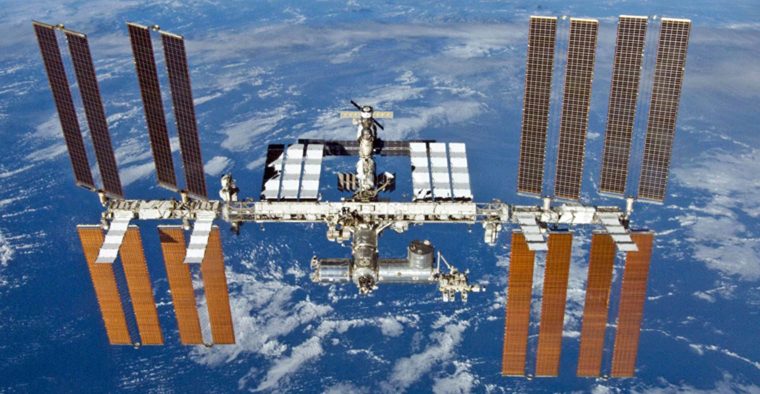 The International Space Station
The International Space Station
Click here to download 300dpi images -
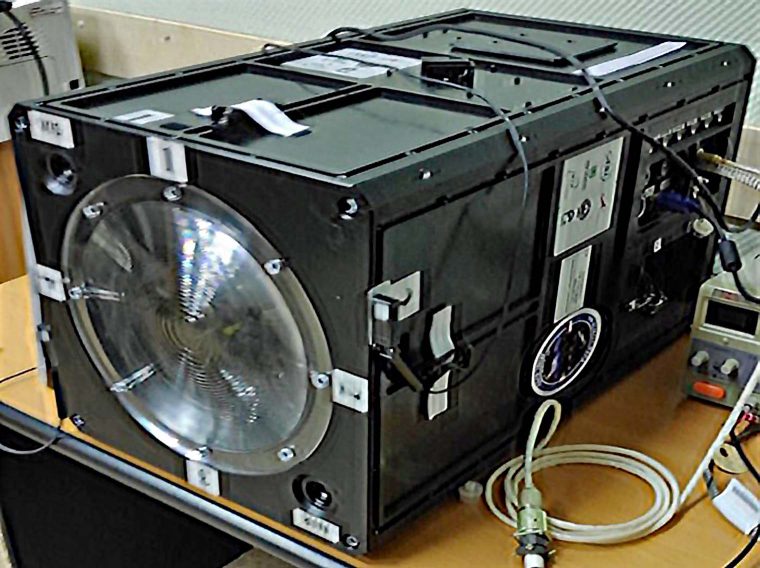 3D printed Mini-EUSO Flight Model, the structure of which was produced in ULTEM™ 9085 resin using a Stratasys Fortus 450mc 3D Printer
3D printed Mini-EUSO Flight Model, the structure of which was produced in ULTEM™ 9085 resin using a Stratasys Fortus 450mc 3D Printer
Click here to download 300dpi images -
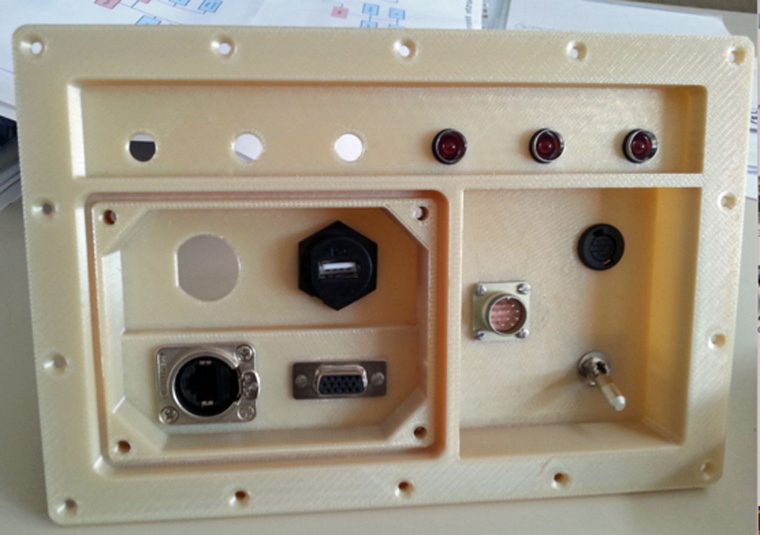 A part of Mini-EUSO produced in ULTEM™ 9085 resin by the team at INFN using its Stratasys Fortus 450mc 3D Printer
A part of Mini-EUSO produced in ULTEM™ 9085 resin by the team at INFN using its Stratasys Fortus 450mc 3D Printer
Click here to download 300dpi images -
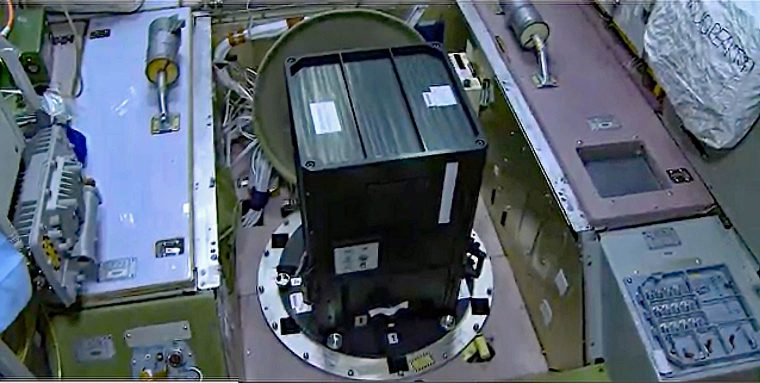 3D printed Mini-EUSO successfully placed on an earth-facing window of the Russian Zvezda module of the ISS
3D printed Mini-EUSO successfully placed on an earth-facing window of the Russian Zvezda module of the ISS
Click here to download 300dpi images -
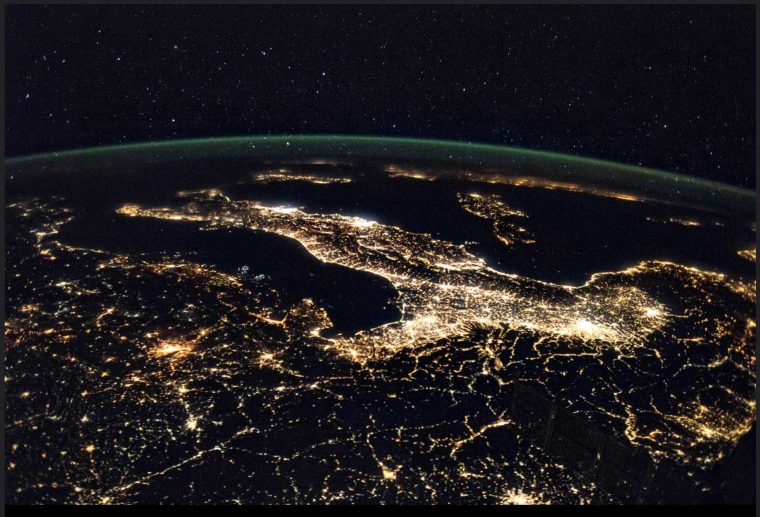 View of Italy from the International Space Station
View of Italy from the International Space Station
Click here to download 300dpi images
L'ISTITUTO NAZIONALE DI FISICA NUCLEARE IN ITALIA RICORRE ALLA STAMPA 3D DI STRATASYS PER FABBRICARE PEZZI CERTIFICATI DA UTILIZZARE SULLA STAZIONE SPAZIALE INTERNAZIONALE
Mini-EUSO, un telescopio cosmico per raggi UV unico nel suo genere, attualmente situato sulla finestra della ISS rivolta verso la Terra, è racchiuso in una struttura integralmente stampata in 3D
L’utilizzo della stampa 3D FDM di Stratasys al posto dell’alluminio ha ridotto di dieci volte i costi di produzione, consentendo di risparmiare quasi un anno di tempo per lo sviluppo
Eden Prairie, Minn., Rehovot, Israele, 21 maggio 2020 Stratasys (Nasdaq: SSYS), fornitore leader di soluzioni di stampa 3D, oggi ha rivelato che la sua tecnologia FDM di livello industriale viene utilizzata per produrre parti stampate in 3D certificate per l’uso sulla Stazione Spaziale Internazionale (ISS). Nell’ambito di un accordo bilaterale stipulato ad hoc tra l’Agenzia Spaziale Italiana (ASI) e l’Agenzia Spaziale Russa Roscosmos, l’Istituto Nazionale di Fisica Nucleare (INFN) ha utilizzato la propria stampante 3D FDM Fortus 450mc di Stratasys per produrre, presso i Laboratori Nazionali di Frascati (Roma), l’intera struttura meccanica del primo telescopio cosmico per raggi UV, attualmente situato a bordo della ISS e realizzato sotto il coordinamento dell’Agenzia Spaziale Italiana.
Progettato per studiare le emissioni ultraviolette di origine cosmica e terrestre dalla ISS, il telescopio denominato ‘Mini-EUSO’ (Multiwavelength Imaging New Instrument for the Extreme Universe Space Observatory) è stato recentemente lanciato nello spazio dalla base di Baikonur (Kazakhstan) a bordo di un razzo russo Soyuz e collocato con successo su una finestra rivolta verso la terra del modulo russo Zvezda della ISS.
“Nel corso di un’orbita di circa 90 minuti, Mini-EUSO registra tutti gli oggetti e gli eventi spaziali e atmosferici captati, comprese le emissioni notturne della Terra nell’ultravioletto, i fenomeni luminosi transienti, le meteore, i detriti spaziali e altro ancora”, spiega Marco Ricci, Primo Ricercatore presso i Laboratori Nazionali INFN di Frascati e Responsabile Nazionale INFN della Collaborazione EUSO SPB2 Italia. “L’obiettivo scientifico finale è quello di produrre una mappa ad alta risoluzione della Terra nell’intervallo UV (300-400 nm), contribuendo in modo significativo all’osservazione e studio dei raggi cosmici dallo spazio e ponendosi come esperimento precursore di future missioni spaziali “.
Secondo Ricci, l’impatto della stampa 3D su questo progetto l’ha trasformato profondamente.
“L’utilizzo della stampa 3D FDM di Stratasys per la fabbricazione della struttura meccanica di Mini-EUSO ci ha permesso di ridurre di dieci volte il costo complessivo del progetto, oltre a farci risparmiare circa un anno intero di tempo di sviluppo. È un risultato sorprendente che non ci saremmo mai aspettati dalla stampa 3D,” ha dichiarato.
La fabbricazione della struttura meccanica di Mini-EUSO presentava diverse difficoltà. In particolare, il team aveva bisogno di un materiale capace di soddisfare i severi requisiti di certificazione dell’industria aerospaziale e della ISS, nonché di sopportare le sollecitazioni meccaniche e le vibrazioni del lancio di un razzo.
“Abbiamo vagliato numerose soluzioni per ottenere le prestazioni richieste nel rispetto della certificazione dei materiali. Abbiamo anche costruito un prototipo completo in alluminio, uno dei materiali più comuni nel settore aerospaziale, ma i risultati non sono stati all’altezza delle aspettative: la struttura era troppo pesante e non garantiva l’isolamento necessario dalle correnti elettriche interne”, spiega Tommaso Napolitano, Responsabile del Servizio di Progettazione e Costruzione Meccanica della Divisione Tecnica dei Laboratori Nazionali INFN di Frascati.
“Di conseguenza, ci siamo rivolti alla nostra stampante 3D Fortus 450mc e abbiamo scoperto che la resina ULTEM™ 9085 offriva l’alternativa perfetta. Non solo il materiale è estremamente resistente, ma è anche leggero. E soprattutto, offre anche eccezionali proprietà isolanti, oltre a un’elevata resistenza chimica e termica. Si può ben dire che se non avessimo potuto stampare la struttura di Mini-EUSO in questo materiale, non avremmo potuto soddisfare i severi parametri di sicurezza e di peso della ISS.”
Il progetto Mini-EUSO, coordinato e finanziato da ASI, è stato sviluppato dalla Collaborazione JEM EUSO (Joint Experiment Missions – Extreme Universe Space Observatory), un programma internazionale più ampio che comprende Francia, Germania, Italia, Giappone, Polonia, Russia, Slovacchia, Svezia, Svizzera e Stati Uniti. L’iniziativa, che si prefigge di esplorare l’origine e la natura dei raggi cosmici di altissima energia provenienti dallo spazio, utilizzerà il telescopio Mini-EUSO stampato in 3D e installato sulla ISS per i prossimi tre anni.
“In questo momento stiamo analizzando i primi dati registrati da Mini-EUSO e i risultati sono molto promettenti. Come ricercatore, sono estremamente orgoglioso del modo in cui il progetto è stato realizzato e molto entusiasta di quello che abbiamo ottenuto. Adesso mi appare chiaro come la stampa 3D possa contribuire in modo significativo ai futuri successi e avanzamenti tecnologici della ricerca scientifica”, conclude Ricci.
L’Istituto Nazionale di Fisica Nucleare (INFN) è un ente pubblico di ricerca italiano incaricato della promozione, del coordinamento e della conduzione della ricerca scientifica nel campo della fisica nucleare, subnucleare e delle astroparticelle. I Laboratori Nazionali di Frascati (LNF) sono uno dei quattro centri nazionali di ricerca di INFN che svolge la propria attività anche in numerose sezioni situate nelle Università sul territorio nazionale. Presso LNF, per l’attività di fabbricazione, il team dispone di diverse stampanti 3D FDM di Stratasys, la più recente delle quali è una Fortus 450mc supplementare fornita dal partner locale di Stratasys, CAD Manager, che fa parte di Energy Group. Inoltre, per potenziare ulteriormente l’attività di progettazione, di recente il team ha introdotto per la prima volta la stampante 3D PolyJet.
-
 La Stazione Spaziale Internazionale
La Stazione Spaziale Internazionale
Click here to download 300dpi images -
 Mini-EUSO Flight Model stampato in 3D, con struttura realizzata in resina ULTEM™ 9085 utilizzando una stampante 3D Stratasys Fortus 450mc
Mini-EUSO Flight Model stampato in 3D, con struttura realizzata in resina ULTEM™ 9085 utilizzando una stampante 3D Stratasys Fortus 450mc
Click here to download 300dpi images -
 Componente di Mini-EUSO realizzato in resina ULTEM™ 9085 dal team dell'INFN utilizzando la stampante 3D Stratasys Fortus 450mc
Componente di Mini-EUSO realizzato in resina ULTEM™ 9085 dal team dell'INFN utilizzando la stampante 3D Stratasys Fortus 450mc
Click here to download 300dpi images -
 Il telescopio Mini-EUSO stampato in 3D, posizionato con successo sulla finestra rivolta verso la Terra del modulo russo Zvezda sulla ISS
Il telescopio Mini-EUSO stampato in 3D, posizionato con successo sulla finestra rivolta verso la Terra del modulo russo Zvezda sulla ISS
Click here to download 300dpi images -
 Veduta dell'Italia dalla Stazione Spaziale Internazionale
Veduta dell'Italia dalla Stazione Spaziale Internazionale
Click here to download 300dpi images
